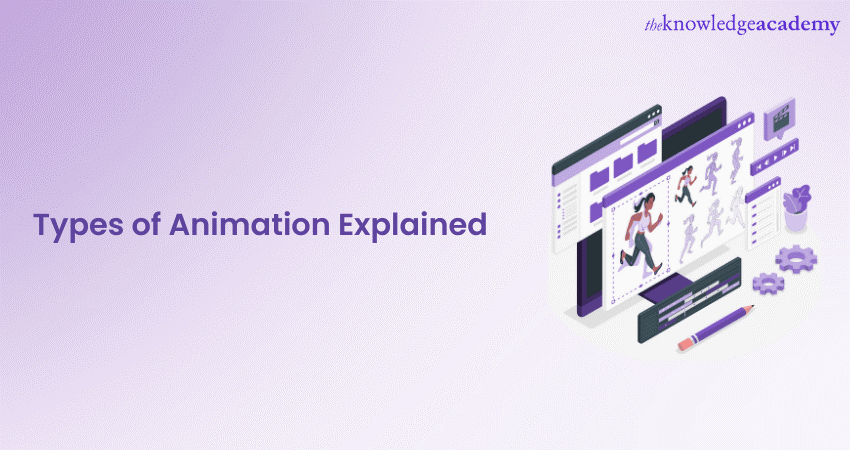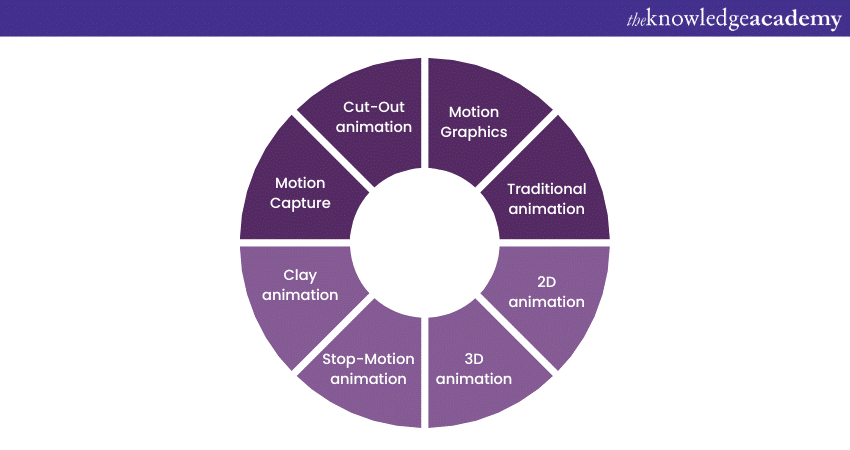We may not have the course you’re looking for. If you enquire or give us a call on +352 8002-6867 and speak to our training experts, we may still be able to help with your training requirements.
We ensure quality, budget-alignment, and timely delivery by our expert instructors.

When you see moving images on a screen, you cannot help but stop and look at them. Since humanity invented ways to capture moments in pictures, it started tinkering with the said images and discovered that they could move. Since its inception, Animation has changed the representation of art. While the world has moved beyond the conventional ways of doing Animation, several new types have also popped up. Read this blog to learn about the various Types of Animation such as Traditional, 2D, 3D, Motion Graphics, Stop Motion Animations, and more.
Table of Contents
1) What is Animation?
2) What are the different Types of Animation?
a) Traditional Animation
b) 2D Animation
c) 3D Animation
d) Motion Graphics
e) Stop Motion Animation
f) Clay Animation
g) Motion Capture
h) Cut-Out Animation
3) Conclusion
What is Animation?
Animation refers to the art of creating motion through pictures. It involves displaying the progression of a scene or a character through a sequence of images. When displayed in quick succession, these images form a motion of sorts. For example, old cartoon-based shows such as Tom and Jerry, Snow White, and Mickey Mouse were created in frames. Each frame would represent a short motion, and when the sequence would be played, viewers would then see characters come to life and perform actions on the screen.
The world of Animation is quite old, and it has been around since the days of black-and-white filmmaking. Back then things were a lot different than today. Many new techniques and types have been discovered and invented since then. Animation still holds significance today because it can capture people’s attention and deliver a message.
Have a bright idea for a feature-length film but don’t know how to animate it? Check out the Animation and Design Training.
What are the different Types of Animation?
You can trace Animation's origins back to 1908 when Emile Cohl created Fantasmagorie. It was all hand-drawn, and the work was tedious and time-consuming. Since then, it has come a long way. Today, with the usage of sophisticated technologies and better insights, people are creating Animations of all types. Let's look at the different Types of Animation:

Traditional Animation
If you recall the previous example of Emil Cohl’s work, Fantasmagorie, that’ll be considered a traditional form of Animation. It includes drawing all the characters and elements in multiple frames by hand. As mentioned above, the process is time-consuming and tedious, but when done right, it can create stellar works of art.
This type of Animation harkens back to the old days when computers were not around. Some of the best-known examples of this kind of Animation include Snow White, Mickey Mouse, Popeye, Sleeping Beauty, and many more. One notable thing about this type of Animation is its dynamic approach toward elements and their movement. Characters on the screen can move about in a scene on a static background. Although perspectives can change backgrounds, for the most part, they remain static. Tools like colour pencils, water colours, and markers are some of the best examples of traditional Animation
2D Animation
Consider this to be a broader class of the previous type. The initial age of Animation was done by hand, and elements were restricted to two axes for movement. It’s just like drawing a comic book; all panels are in a 2D plane, and the story progresses within the confines of the 2D plane. This type of Animation is still present and is used for different purposes.
From entertainment to education through storytelling, 2D Animation is used almost everywhere. An average Animation creation sequence involves creating 24 frames for one second. At times Animators prefer Animating every second frame, which leads them to create 12 frames. But that depends on the project's nature and the hour's requirement. Over the years, Animators have begun using tools to create Animation.
They’ve also begun using “skeletons” for elements that need to be drawn again and again in multiple frames. Some of the best 2D Animation examples include movies like The Lion King, Spirited Away, and Beauty and the Beast. Adobe After Effects and Toon Boom Harmony are some of the prominent tools for 2D Animation include:
Want to get into 2D Animation but don’t know its governing principles? Join our 2D Animation Training and get a kick-start for your Animation career.
3D Animation
3D Animation is an upgraded version of 2D Animation. All the elements, including the background and environment, are designed and created in a 3D plane. While the movement in 2D Animation could only happen in two axes, 3D Animation gives a 3D space to perform different kinds of motions. Elements can engage with other elements as well in 3D Animation.
Just like in 2D Animation, Animators also use “Skeletons” in 3D Animation. However, their usage has transcended from being used as a reference to ease element creation. Skeletons can now be used to create 3D models of objects that can behave realistically in an environment. Depending on the type of project or the physics engine in use, they can be created to study deformation, stress, and other changes to their physical structure.
Examples of this Animation type include movies such as Toy Story, Shrek, and Cars. Videogame franchises such as Halo, Call of Duty, and Half-Life have been built around 3D Animation as well. Maya and Blender are some of the key tools used here.
Motion Graphics
Think of this one as the kind of Animation you see when you watch a movie’s opening credits. The different ways in which pieces of text pop up on the screen, using different kinds of effects, you’ve seen them a lot. Every TV product or service advertisement comes with its fair share of Motion Graphics. It is one of the prominent Types of Animation that has gained immense traction lately.
The recent trend of minimalism heavily incorporates types of Motion Graphics. Organizations like Apple, Microsoft, Figma, and many others utilize Motion Graphics for product ads and general promotions. One notable aspect of Motion Graphics is its versatility, as it can be applied to both 2D and 3D animation.
Dissect the ways to create the illusion of Motion Graphics in space and time to achieve your objectives with the Motion Graphics Masterclass.
Stop Motion Animation
Stop Motion Animation is nothing but a sequence of images that are either filmed or shot. Their distinct frame rates are chief identifiers. They have this choppy flow to them that creates a different but interesting viewing experience. The best part about this form of Animation is that you can create it using basic tools and props. Pieces of clothes, toys, clay models, etc. can easily be used to make stop-motion Animation.
Movies such as Fantastic Mr. Fox, Nightmare Before Christmas, and Corpse Bride are some excellent examples of this Animation type. If you have an idea and a few props that will do the job well, you can easily begin making your own Animation.
For the most part, simple editing tools can do the job well, as you’re required to click pictures or do a recording. However, you can use some tools that deal with Stop Motion Animation, such as Stop Motion Studio, Dragonframe, and iStopMotion.
Clay Animation
A subset of stop motion Animation, clay Animation extensively uses clay as the key element for presentation. Nearly every element of the presentation is made of clay. This Animation process requires a lot of man-hours and cannot be done using digital tools. There’s simply no workaround for this.
Perhaps the most famous example of this Animation type is the show Wallace and Gromit. Every character was made of clay, and the movements were choppy. It had a Stop Motion like aesthetic, which made the show memorable for a lot of people. While this Animation is created using manual sculpting skills, few software tools such as Stop Motion Studio, Dragonframe, iStopMotion, and others that are helpful.
Motion Capture
This is where human input gets directly translated into 3D motion. Motion Capture is widely used in filmmaking and video game development. It involves the use of motion capture sensors that are placed on objects and, at times, on people. Once placed, the sensors then record the movements of elements in a given scene or frame. The recorded data is then collected and compiled.
Upon compilation, the data is then translated into 3D Animation through different pieces of software. There are a number of tools that are deployed to record and translate the raw data into Animation. It is a complex process that requires a lot of skill; however, if pulled off successfully, the results can be brilliant.
Video games such as LA Noire, Grand Theft Auto V, and the God of War Reboot are some of the best examples of excellent motion capture. Additional examples include movies like Lord of the Rings and Ready Player One. Tools like Blender, Autodesk Maya, Motion Builder, and others help convert the sensor data into 3D Animation.
Cut-Out Animation
As the name suggests, Cut-Out Animation is done with paper and cardboard cut-outs. This type of Animation is unique as it represents static characters. These characters move in a staggered manner that resembles puppets. Cut-Out Animation is another subset of Stop Motion Animation. Videogames and TV shows have inculcated this Animation type into various projects.
While the process sometimes yields good results, it is a time-consuming process as the elements are often hand-drawn. Notable examples of this Animation type include shows such as South Park and Monty Python’s Flying Circus. Paper Mario also happens to be a famous example of interactive media using cut-out Animation in essence.
While conventional tools include paper, colours, and a pair of scissors, modern-day software tools are helpful as well. Adobe Animate, Toon Boom Harmony, Stop Motion Studio, and others are some of the tools that help in such type of Animation.
Conclusion
We hope you enjoyed reading this blog on the Types of Animation. There are several ways with which ideas can be represented in popular media and Animation is perhaps the most prominent one among all. You can even blend in multiple Types of Animation to create a highly enjoyable experience. At the end of the day, it all boils down to your preference and creativity. Deploy the right tools at the right time and who knows, you might end up creating a cultural masterpiece.
Having trouble creating cohesive and meaningful works of art that can be used for framing and Animation? Here’s the Drawing Masterclass you’ve been looking for.
Frequently Asked Questions
Upcoming Office Applications Resources Batches & Dates
Date
 Articulate Storyline Training
Articulate Storyline Training
Fri 14th Mar 2025
Fri 9th May 2025
Fri 11th Jul 2025
Fri 12th Sep 2025
Fri 14th Nov 2025






 Top Rated Course
Top Rated Course



 If you wish to make any changes to your course, please
If you wish to make any changes to your course, please


